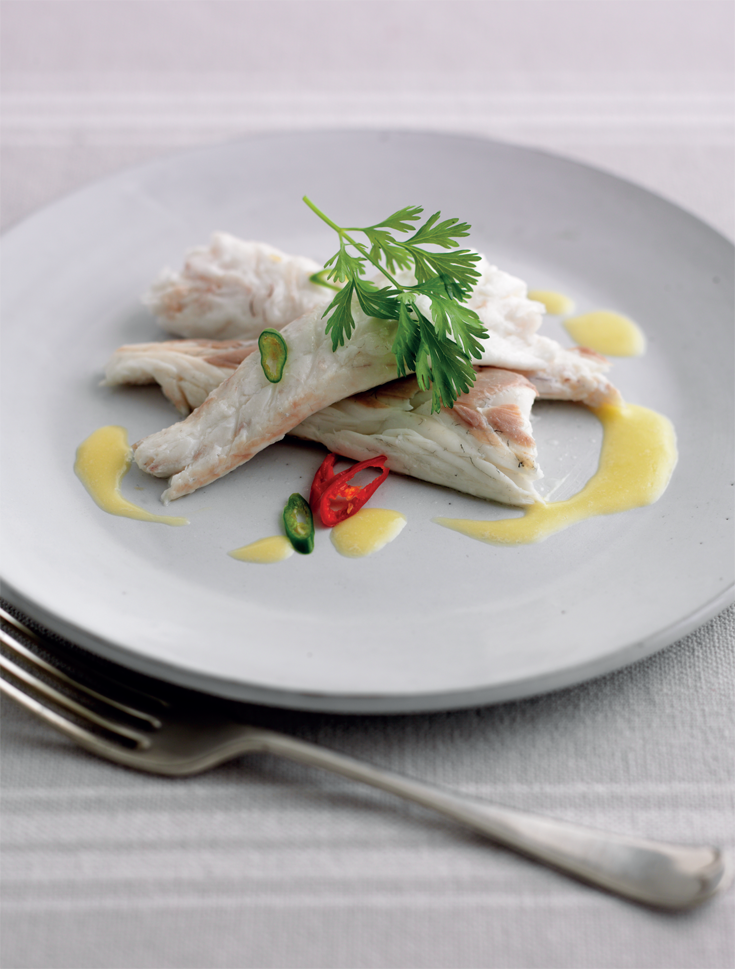Lifestyle
Sea bass baked in a Maldon sea salt crust
8 April 2013 by Admin in Lifestyle
1 x 1–1.5kg sea bass, gutted and
scaled
For the salt crust mix:
1.5kg Maldon sea salt
1 heaped tbsp coriander seeds
1 level tbsp black peppercorns
½ tbsp Szechuan peppercorns,
slightly crushed
½ tbsp fennel seeds
12 cardamom seeds, slightly crushed
10 star anise
I egg white, beaten (optional)
For the filling:
1 stick lemongrass
3 sprigs fresh coriander
2 lime leaves, cut in half
5 thin slices fresh ginger
1 mild red or green chilli,
split in two and deseeded
For the beurre blanc:
50g Thai shallots, finely chopped
1 glass of Sancerre
½ glass white wine vinegar
250g unsalted butter, cut into small
cubes and refrigerated
2 sprigs coriander
1 tsp chopped lemongrass
half a lime leaf
1 heaped tsp chopped sushi ginger
juice of 1 lime
½ tsp wasabi paste
Serves 4
Mix all the salt crust ingredients, except the optional egg white, together well. It’s best to prepare this dry mix two to three days in advance so it can infuse; just store it in an airtight container. It will keep for the next time, too.
Dry the sea bass well and stuff it with all the ingredients for the filling, making sure they are evenly spread out inside it.
Preheat the oven to 200°C/400°F/gas 6. You will need a sheet of silicone or parchment paper 70cm x 50cm in size; fold it so that you have a sheet of about 35cm x 50cm. Fold or crimp up the edges so they form a little lip and place the sheet on a flat baking tray.
Mix the egg white into the salt mix (it will help to hold the crust together, giving you a harder crust and enabling you to mould it to shape, but alternatively you could simply spray the fish with water once you have finished covering it with the mix). Put a layer of the salt mix in the middle of the paper the size and shape of the bass. Very carefully place the fish on top. Cover it completely with plenty of the salt. Bake it in the oven for about 35–45 minutes. Test it with a probe to make sure the inside is hot. Make the beurre blanc while the fish is cooking. Place the shallots, wine and vinegar in a stainless steel pan over a high heat and reduce until only a few tablespoons of liquid are left. Lower the heat slightly and whisk in the cold butter piece by piece, whisking constantly until you have a velvety beurre blanc – remove the pan from the heat just before adding the last piece of butter. Add all the other ingredients except the lime juice and wasabi and let them infuse while the bass is baking. Keep the sauce warm, preferably by putting the pan in a bain-marie, a container of warm water – but not too warm, or the sauce may split. Adjust the seasoning just before serving and add the lime juice and wasabi. Strain the sauce through a fine sieve just before serving.
To serve the bass, crack open the crust and divide the fish between the plates; serve with the perfumed beurre blanc.
This recipe is from Desert Island Dishes and Copyright of Maldon Salt Company Limited 2012
How To Declutter A House
1 April 2013 by Infinite Ideas in Lifestyle
Decluttering is the new black. Whether you want to make extra space or simply clear up your home, get set for a brutal experience.
There is a way of tackling tidying that lacks commitment. It involves tucking papers in drawers, putting magazines back in the rack and working on the assumption that ‘I might use it one day’.
Stop right now, thank you very much, in the words of the immortal Spice Girls. If you are going to declutter you need to approach it with dedication and verve and most importantly, with a lack of sentimentality.
 Pick a room – any room – and sit in the middle. What you are about to do is remove roughly one-quarter of the contents in that space. That’s your target. (And that’s just for starters. Once you have performed your initial declutter, if you are really serious about it I want you to go back a week later and repeat the process.) In the kitchen: you are chucking out unused spices, old tins, battered bakeware, chipped crockery, fraying table linen, knackered saucepans and unused gadgets (bread makers and juicers being chief culprits). In the lounge: you are getting rid of books on the bookshelf (that’s where the sentimental bit comes in for me; I hate getting rid of books), China ornaments that were dodgy holiday mementoes or suspect gifts, dried flower arrangements, worn out cushions and old CDs. In the bedroom: you are looking to give many, many items of clothing to the charity shop. If you keep your bed linen in there, how many sets do you realistically need? If you’ve mislaid one of a matching pair of pillowcases chuck the odd one out – if you take it downstairs to the kitchen to cut up and use as cleaning cloths you are only adding to the clutter down there, so chuck it.
Pick a room – any room – and sit in the middle. What you are about to do is remove roughly one-quarter of the contents in that space. That’s your target. (And that’s just for starters. Once you have performed your initial declutter, if you are really serious about it I want you to go back a week later and repeat the process.) In the kitchen: you are chucking out unused spices, old tins, battered bakeware, chipped crockery, fraying table linen, knackered saucepans and unused gadgets (bread makers and juicers being chief culprits). In the lounge: you are getting rid of books on the bookshelf (that’s where the sentimental bit comes in for me; I hate getting rid of books), China ornaments that were dodgy holiday mementoes or suspect gifts, dried flower arrangements, worn out cushions and old CDs. In the bedroom: you are looking to give many, many items of clothing to the charity shop. If you keep your bed linen in there, how many sets do you realistically need? If you’ve mislaid one of a matching pair of pillowcases chuck the odd one out – if you take it downstairs to the kitchen to cut up and use as cleaning cloths you are only adding to the clutter down there, so chuck it.
In the bathroom: it’s time to dispose of old make-up, old medicines, half-used body lotions and potions and towels that were stained by your last hair-dyeing experiment. It’s all very well thinking ‘I’ll use that at the beach’, but when was the last time you remembered to take a spare towel with you? It’s a process that is loosely based on the William Morris principle ‘Have nothing in your houses that you do not know to be useful, or believe to be beautiful.’ And it makes absolute sense. Most of our clutter is just a home for dust and dirt. So here’s how to approach the job. Start in the corner furthest away from the door. If there’s a rug on the floor or a cushion that needs to go, take it out of the room and put it in a pile outside the door. If there’s a cupboard in the corner, open the door and, starting from the top, take out everything that’s on the shelf. For each item ask yourself when was the last time that you looked at it, read it, used it or even thought about it. If you can’t remember any of the above then take it out of the room and add it to the pile. If the cupboard is not sectioned off, bring in some new storage systems: box files for papers, garments bags for clothes, etc.
I should mention at this point that it might be worth having a bottle chilling in the fridge, because you will need an incentive after and hour of two of doing this. Also, in the same way that people jog to pacey music or work out to funk, make sure that you are listening to something inspirational. I mix up a bit of Barry White, some Stone Roses, very early Michael Jackson and a bit of Bruce Springsteen. It all gets me moving one way or another.
Don’t give up when you get bored: the aim is to clear the excess baggage in one sitting. You have to look on it as a job that needs completing before you are allowed that glass of wine, not reach for the bottle when you are halfway through. Take everything that you’ve removed and recycle it in the appropriate way.
Approach decluttering with the determination of a pitbull and you’ll reap the rewards in terms of tidiness, cleanliness and lots of lovely extra space.
Reducing Your Carbon Footprint
1 March 2013 by Infinite Ideas in Lifestyle
‘Carbon footprint’ is the buzzword when it comes to living a greener life. We all have one we shouldn’t, and the fastest way to reduce it is to make your home a greener place.
Your home is probably your main source of pollution. Hard to accept, isn’t it? But once you turn eco-spy, you’ll find ways of making it green.
Everyone’s heard the saying ‘think global, act local.’ Well, your own home is about as local as it gets. And the way you live at home can have worldwide implications.
Let’s start with the all-important carbon footprint that everyone’s talking about at the moment. The main thing about it is, we don’t want one! Or at least, we want a small one, so in this case, size does matter.
 Your carbon footprint is the imprint your activities leave on the environment in terms of the amount of greenhouse gases produced, measured in units of carbon dioxide. Everything you do at home, from the way you dispose of waste to the temperature on your thermostat, has an impact on the size of your carbon footprint.
Your carbon footprint is the imprint your activities leave on the environment in terms of the amount of greenhouse gases produced, measured in units of carbon dioxide. Everything you do at home, from the way you dispose of waste to the temperature on your thermostat, has an impact on the size of your carbon footprint.
And man-made CO2 is one of the biggest contributors to global warming. The net result of this climate change is sadly not going to be lovely hot summers and pleasant, mild winters. Instead, glaciers and sea ice would melt, sea levels would rise, and coastal areas would flood. Inland areas would become hotter and drier, and lakes and rivers could dry up. There would be more droughts, making it hard to grow crops, and some plants and animals might become extinct because of the heat. Hurricanes, tornadoes and other storms may get more common.
Overall, the cost to society, the environment, our health and the economy is likely to far outweigh any benefits.
But we can all help contain global warming, starting with minimising your footprint – and there’s no time like the present. We’ll be looking at ways of reducing your carbon footprint throughout this book, but there are things you can do today, in your home, to reduce your contribution to global warming. Best of all, they should not cost you a penny, and in the long term will save you cash.
- Sign up to a green energy supplier.
- Turn down the central and water heating slightly.
- Use dishwashers, washing machines and driers to full capacity, or use half-load programmes.
- Don’t leave appliances on standby.
- Hang out the washing to dry rather than tumble-drying.
- Fit energy-saving light bulbs.
- Insulate your hot water tank, your loft and your walls.
- Recycle and reuse.
- Save water by harvesting rainwater, reusing ‘grey’ water and cutting down on hosing.
Apart from global warming, general pollution threatens our health, crops and wildlife. You can help reduce pollution with all of the above steps. As a bonus, you could also switch to organic food, and use fewer chemicals around the home.
Once you’ve got the ball rolling, make sure your whole household is involved. Get teenagers to switch off gadgets and lights when not in use; explain to the kids how recycling works and ask them to help you sort your waste into the right bins; persuade Granny to share her make-do-and-mend tips and Grandad his compost recipe. Encourage the whole family to cut back on water usage, for instance by not leaving taps running; and get everyone used to having the house slightly cooler. And just watch your carbon footprint shrink!
Flirting Tips & Ideas
1 March 2013 by Infinite Ideas in Lifestyle
Everyone knows someone who is an incredible flirt, whose social diary always seems to need extra fold-out sections and who seems to be adored by all men, from infants to grandfathers.
Rather than make a voodoo doll of her, watch and learn: the good and the bad.
But she’s so obvious!
Most women with these skills often seem transparent to other women; they seem to turn on the charm unashamedly and suck up to a man’s ego without a second thought. Well: newsflash – men don’t care. And more often than not, they usually don’t even notice that she does it to every other guy in the office unless she is known as the ‘praying mantis’ and eats her partners after sex. This is because most people could do with a little extra attention in their lives. Face it, even if you know the guy in accounts flirts with every woman he meets on the stairs, it still makes your day less dreary – and that’s because flirting makes life more fun.
Flirting also doesn’t have to be about sex. It can just be about remembering to look up, crack a smile and not take everything so seriously. You may not have just made a connection with the love of your life but it’s good to remember to keep things light; it’s a great way to stop every date you do have from seeming like a full-scale interview.
Most good flirts have a few skills in common. Firstly, they smile a lot. That is not to say that they could be extras in The Stepford Wives. They just keep things upbeat, a quality that draws people whether they are friends or colleagues. Secondly, they ask questions and remember details; any good networker will tell you that this is an essential tool in making good contacts. It makes people feel appreciated, understood and special, so try and make a mental rule to ask more questions than you answer. Again, this will not turn you into some 50s housewife; it’s as useful a skill in big business as it is in personal relationships. And thirdly, they often use physical contact, sometimes with themselves, and sometimes with others. Touching your hair or face gives the other person a clear signal that you are interested in them. Touching their arm or hand as you chat, taking their elbow as you go through a door – these are all ways of making people know that you are comfortable with the idea of being in their body space: or of having them in yours.
Getting flirting right for you
That isn’t to say these are all right for you. If every time you see the arch-flirt you want to lock her in the stationary cupboard for pretending she can’t work the photocopier when she used to work for Xerox, then you know you need to modify her tactics when you use them yourself. Maybe you can emulate the way she remembers everyone’s name or gets involved with after-work activities (you might not fancy Bob in IT, but his brother could be pretty hot). It’s about knowing that you might need to sharpen up your skills consciously without coming into work the next day with a completely different personality. You can use what she does wrong to help guide you: maybe her whole conversation is about the other person, which is a great way to get attention but isn’t going to help move things on to the next stage. Maybe the neckline of her blouse ends around her waistband; also not a winner with every guy in town. The wise girl looks for lessons everywhere.
What comes naturally
This is why you also need to think about how you already put yourself out there. Are you always coming up with wisecracks or reminding men you meet how smart you are? Do you find yourself joking about, like you did with your male friends at college or your ex-boyfriend? Whilst this might be a great place to get to with a partner, it’s not necessarily ideal when you first meet someone. Most people have a limit to how much they can take in during one sitting and definitely to how much they want to know. You may think chatting about your ex, your eating disorder and your PhD just shows your openness, but is it possible that you might be scaring people off by showing what a handful you are? Revealing yourself as you get to know one another is a much better way of allowing space for both of you to get comfortable.


